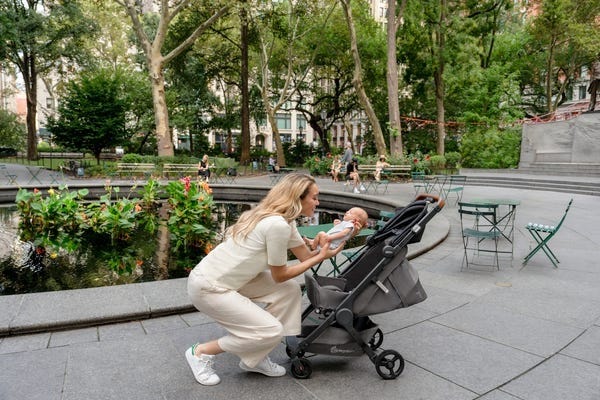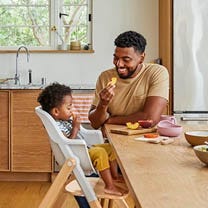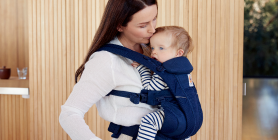
By definition, a baby carrier is a device used to carry an infant or small child on the body of an adult caregiver. On-the-body baby carriers are designed in various forms such as slings, wraps, and soft structured front, back or hip carriers. Varying materials and degrees of rigidity, decoration, and support are used for carrying the child. Here are a few common types of baby carriers and some considerations for choosing a baby carrier that best suits your family.
Slings
Slings are a baby carrying device comprised of a piece of cloth. The ends of the cloth are linked together, sometimes with a metal ring on one end and known as a Ring Sling. It is "slung over the shoulder and a pouch to put the baby in is formed at the wearer's waist.
Wraps
A wrap carrier does exactly what it sounds like: it wraps itself around you and your baby. A wrap is a long strip of fabric that goes around the wearer's body several times and is tied in a way that creates a secure pocket for the baby to sit or lay. The wrap is usually positioned over the wearer's shoulders.
Soft Structured Baby Carriers
A lot of moms and dads feel more comfortable with an original baby carrier that has more structure. With its padded shoulder straps and safety buckles, a soft structured front baby carrier is easy to secure. It is also very versatile, in the front, hip, and back positions, and can carry a lot of weight. They distribute the parent's weight more evenly over their shoulders and back. When using a soft structured carrier, either a three-position or four-position baby carrier, keep in mind you may need to use an infant insert until baby has strong head control and can comfortably sit in a spread squat position in the baby carrier. For more information, click here. Try out any baby carrier you are considering buying to see if it suits you. Ask friends if you can borrow theirs for a trial. Or, better yet, check to see if there is a babywearing group in your area. Check with shops and internet sites to be sure you will be able to return the baby carrier (undamaged, unstained, and in original packaging) if it turns out to be uncomfortable.
Features to Look For in a Baby Carrier
- Holds baby in a safe, comfortable position
- Fits all those who will regularly carry the baby
- Adjustable soft padded shoulder straps and waist belts that are fairly wide and don't twist. Unpadded straps tend to cut in, making shoulders, necks, and backs ache.
- Secure and easy to operate straps, buckles, and snaps
- Straps that can be easily adjusted, if necessary with the baby in the baby carrier
- Adjustable to baby's growth
- Machine washable
- Light and foldable (if you plan to pack it for travel)
- Nursing-friendly baby carrier (if you are or plan on nursing)
Some Safety Tips for Using a Baby Carrier:
- Baby should be worn high on the parent's body, close enough to kiss. If a baby is worn too low, it becomes hard to see the baby and monitor her breathing. Wearer must check to be sure baby's airway is clear and that baby is breathing normally at all times.
- Watch your step and vantage point. Your balance can be affected while using a baby carrier.
- Use common sense when babywearing. Do not perform any activities that would require the use of safety equipment (bicycling, riding a horse, etc.) and always bend at the knees when babywearing.
You can read more safety tips from our friends at Babywearing International here. What is the best baby carrier for your family? Think about your lifestyle and how you will incorporate baby into your lifestyle. Will you primarily be using the baby carrier around the house? Are you an outdoor enthusiast? Will you be using a different baby carrier for each caregiver? Read more here.
Emotional Benefits of Getting Outside
Spending time in nature with your baby can strengthen the bond between you. The simple act of holding your baby close, feeling their warmth, and sharing new experiences together can create strong emotional connections. It’s also a wonderful way to reduce stress and improve your mood. When my littles were extra fussy, I’d take a walk around the neighborhood. Even though I don't live in an area with trails and surrounded by nature, simply behind outside changed everything. A little vitamin D does wonders!
Cognitive Development
Nature is a sensory wonderland for babies. The different sights, sounds, and smells can stimulate your baby’s senses and promote cognitive development. Watching leaves rustle, hearing birds chirp, and feeling the texture of a tree bark can all contribute to their learning and development.
All About Baby Carriers for Nature Adventures
Choosing the Right Baby Carrier
When it comes to selecting the best baby carrier for summer adventures, there are several options to consider.
Types of Baby Carriers:
- Wraps: Perfect for newborns, providing a snug and secure fit.
- Slings: Ideal for quick and easy use, offering good ventilation.
- Soft Structured Carriers: Versatile and comfortable for both parent and baby, suitable for longer trips.
Factors to Consider:
- Baby’s Age and Weight: Ensure the carrier is appropriate for your baby’s size and weight. For example, Ergobaby’s Embrace Newborn Carrier is perfect for the fourth trimester where baby is small and you’re looking for an easy way to stay close. As they grow, you’ll want to upgrade to an all-position carrier that’s meant for growing babies.
- Parent’s Comfort and Ergonomics: Look for carriers with padded shoulder straps and lumbar support if you’re planning on longer outings.
- Ease of Use: Choose a carrier that is easy to put on and take off.
- Climate and Breathability: Opt for carriers made of breathable fabrics to keep you and your baby cool in hot weather.
Safety Tips:
- Proper Positioning: Ensure your baby is seated correctly, with their legs in an "M" position and their head should be close enough to kiss.
- Checking for Wear and Tear: Regularly inspect your carrier for any signs of damage.
- Ensuring Adequate Support: Make sure the carrier provides proper support for your baby’s head and neck.
Exploring Nature with a Baby Carrier
Ideal Spots for a Nature Walk with Baby
- Parks and Gardens: Great for leisurely walks and picnics.
- Nature Trails and Forests: Perfect for more adventurous outings.
- Beaches and Lakesides: Wonderful for enjoying the water and sand, with the right carrier.
Activity Ideas
- Hiking: Enjoy a scenic hike with a hiking baby carrier that offers support and storage.
- Bird Watching: Use your carrier to keep your baby close while you explore and observe wildlife.
- Picnics: A carrier can free up your hands, making it easier to carry picnic supplies.


Advantages of Using Strollers for Nature Adventures


While baby carriers are fantastic for mobility and closeness, depending on the adventure of choice you might want to be a stroller along too.
There are a LOT of baby stroller options on the market. So we understand how confusing it can be to choose the one that’s right for your family. Not only are there a variety of brands, but a variety of strollers that serve different purposes.
There are a few types of strollers on the market:
- Full-sized stroller: This is typically the stroller parents thing of buying for all its versatility.
- Lightweight or umbrella stroller:These compact strollers are perfect for on-the-go adventures.
- Jogging stroller: Designed for parents who want to combine fitness with outdoor adventures.
- Double stroller: Designed for parents with multiple kids, especially twins.
- Car seat carrier: These strollers connect to a specific car seat. We don't typically recommend these as they can be unsafe for baby and uncomfortable for parents who are pushing.
Learn more about the types of strollers and which one would be best for you.
Benefits of Bringing a Stroller
- Storage Space for Gear: Ample room for carrying all your essentials like a diaper bag, beach toys and more.
- Shade and Weather Protection: Built-in canopies to shield your baby from the sun when they are lounging.
- Options: If you have more than one kid, you can stroll with one and carry the other. Or, if you’re getting warm or your little one is getting fussy, you can switch up their position from stroller to carrier or vice versa.
Safety Tips for Strollers
- Ensure your stroller is in good working condition. Make sure buckles are still buckling and that there are no rips or holes that could compromise your baby’s safety.
- Use sunshades or bug nets to protect your little one’s skin.
- Securing the baby properly: always buckle up your baby for safety even if you think they are old enough to go without the buckle.
Combining Baby Carriers and Strollers
For the ultimate flexibility, consider using both a baby carrier and a stroller on your outings.
Combining both options allows you to adapt to different situations. Use the carrier for more rugged trails and switch to the stroller for smoother paths or when your baby needs a nap.
Transition Tips
- Smooth Transitions: Plan stops where you can easily switch from carrier to stroller.
- Pack Light: Only bring essentials to make transitions easier.
Tips for a Successful Adventure
Planning Ahead
- Route Planning: Choose baby-friendly trails and parks. Check local mom groups or outdoor groups and get recommendations for the best outings for kids.
- Check Weather Conditions: Avoid extreme heat or unpredictable weather. Even with our most breathable carriers, when it’s hot, it’s hot. And having two bodies against each other in the heat will be naturally hot and sticky already.
- Packing Checklist: Include diapers, snacks, water, sunscreen, and a first-aid kit. These all-position carriers have storage pockets where you can fit some of the items easily!
- Stay Hydrated and Nourished: Pack healthy snacks to keep energy levels up and bring plenty of water for both you and baby.


Summer adventures with your baby are a wonderful way to create lasting memories and enjoy the beauty of nature together. From baby carriers to strollers, Ergobaby products are designed to provide comfort and ease for both you and your little one. So, gear up, get outside, and explore the world with your baby by your side.
Ready to embark on your own summer adventures? Check out Ergobaby’s range of baby carriers and strollers to find the perfect match for your family’s needs. Visit our website today and start planning your next outdoor excursion!



























